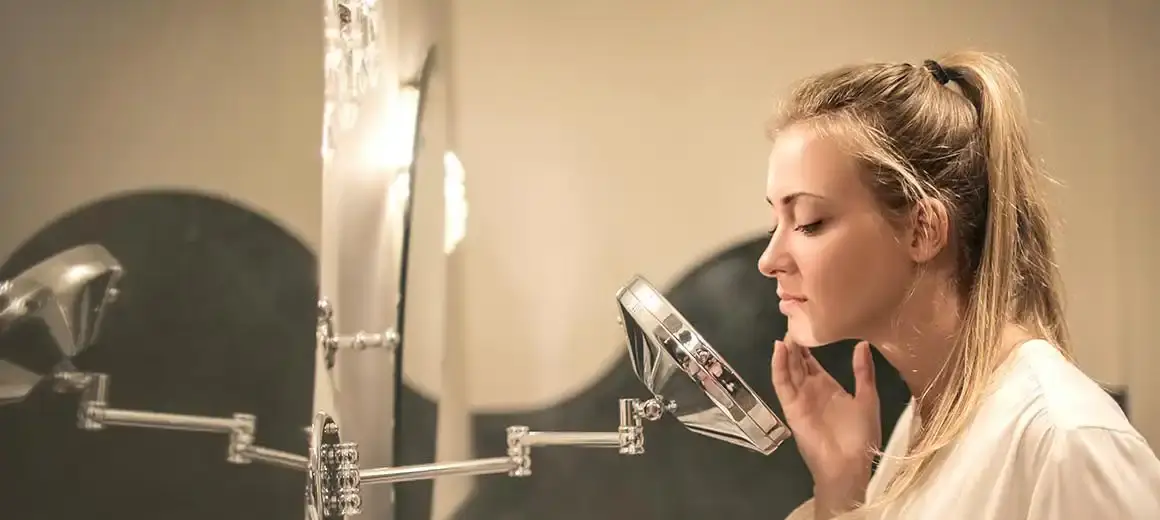Is Your Acne Hormonal or Mask Acne?

- April 26, 2022
- by The Ginger-U Team
Acne at any age is really bothersome. It can impact one’s confidence, social life, and even career. Hormonal fluctuation or imbalance is the primary reason for acne in women. Other causes include genetics, the effects of certain medications, and wearing a mask. Yes! You read that right. The nearly ubiquitous mask worn to prevent COVID infection may cause acne, aka maskne. So how do you know whether your acne is hormonal or mask-related acne? Continue reading to learn more.
What is Hormonal Acne, and Why Does It Happen?
Hormonal acne includes blackheads, whiteheads, pimples, and painful cysts on the forehead, nose, and chin. It forms on the bottom of your cheeks and around the jawline in older women. Hormonal changes during puberty, menstruation, pregnancy, and menopause or hormone disorders (for example, PCOS/PCOD) also bring on acne. These conditions lead to increased sebum production, growth of P.acnes bacteria, and overall skin inflammation. The interaction of sebum and bacteria clog pores and causes acne.
What is Mask Acne, And Why Does It Happen?
Mask acne (aka maskne) refers to the pimples, redness, bumps, and irritation caused by the build-up of sebum, sweat, and dead cells under a mask. Hot and humid weather increases the possibility of developing maskne, because it creates an ideal environment for the growth of bacteria and yeast. Besides, friction from the mask may also trigger or aggravate acne or other skin problems like perioral dermatitis and folliculitis.
How Do You Know If You Have Maskne or Hormonal Acne?
Determining whether your acne is hormonal or mask-related depends on the following factors.
Facial region
Hormonal acne forms on the forehead, mid-face, chin, and jawline, whereas maskne affects the areas covered by a mask—the nose and perioral regions.
Symptoms
Blackheads, whiteheads, pimples, nodules, and cysts are the manifestations of hormonal acne. However, blackheads, whiteheads, and pimples may also form when you neglect regular skincare. Hormonal acne may turn painful, but it is less likely to itch unless your skin is too dry or you have an existing skin condition like dermatitis or rosacea.
Maskne, on the other hand, causes irritation, redness, papules, or pustules. The breakout may occur immediately or a few days after you have started wearing a mask, especially when you wear it for long hours every day. Maskne may worsen perioral dermatitis, atopic dermatitis, or hormonal acne.
Timing
Hormonal acne flares up on the days leading up to your periods, during pregnancy, and when menopause is approaching. In addition, endocrine disorders like PCOS/PCOD, Cushing’s syndrome, androgen-secreting tumors, and acromegaly make hormonal acne worse and more frequent. On the other hand, maskne can appear anytime if you have been wearing face masks regularly. It is worth noting that women with hormonal acne may develop maskne, and vice-versa. Consulting a gynecologist is the best way to know your acne type.
How To Treat Hormonal Acne and Maskne?
Washing your face with a soap-free and non-comedogenic face wash twice a day is the first step to preventing or treating both types of acne. In addition, ceramide moisturizers that are non-sticky help repair the skin’s natural barrier and may prevent acne from getting worse. Consider using mineral sunscreen every time you step out in the sun. Mask breaks or switching to mulberry silk masks are also suggested for maskne treatment.
Visit a dermatologist for maskne or hormonal acne treatment if the condition exacerbates despite taking precautions. Birth control pills, antibiotics, hormonal therapy, and topical products are generally prescribed to treat hormonal acne. On the other hand, topical anti-acne creams, lotions, or gels with or without hydrocortisone cream are prescribed to treat maskne.

Comment